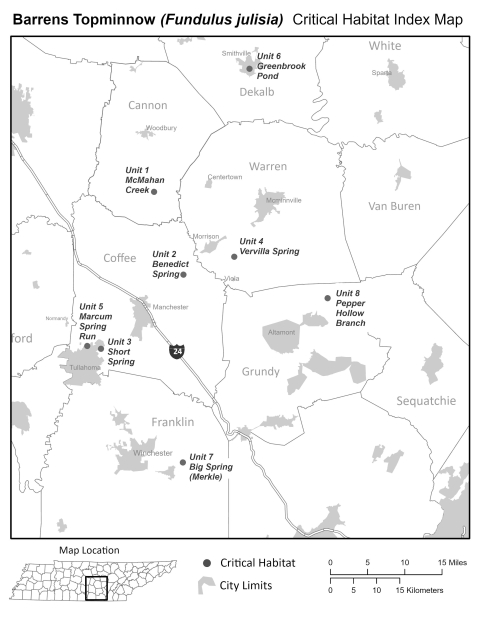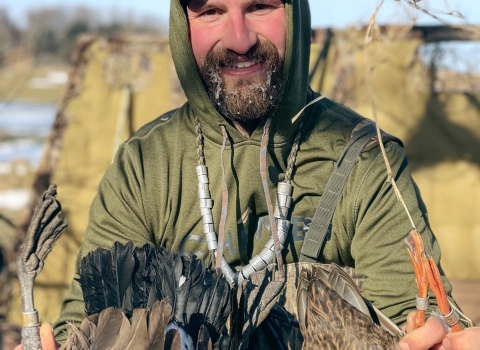What is the Barrens topminnow? Where does it occur?
The Barrens topminnow is a small colorful fish. It occurs in groundwater-fed spring pools (pond-like areas) and runs (small streams) in middle Tennessee, on the Cumberland Plateau physiographic province, in Cannon, Coffee, Dekalb, Franklin, Grundy, and Warren Counties. The species was listed as endangered November 2019 due to significant predation from the western mosquitofish.
What action is the U.S. Fish and Wildlife Service proposing?
The Service is proposing to designate critical habitat for the endangered Barrens topminnow. In total, approximately 1.5 of spring pool and 11.4 miles of spring run are being proposed for designation. The Service is seeking comments on these proposed actions and accompanying documents.
What are the threats to the Barrens topminnow?
The most important factor affecting the status of the Barrens topminnow is western mosquitofish. Mosquitofish are native to portions of western Tennessee and were introduced to the Barrens Plateau and many other sites in North America in the mid-twentieth century in attempt to control mosquitos. Mosquitofish prey on young topminnows and harass adults. Except for one known instance, once mosquitofish were established at a Barrens topminnow site, Barrens topminnows were extirpated within three to five years.
What is critical habitat?
The Endangered Species Act defines critical habitat as the specific geographic areas that contain features essential to the conservation of an endangered or threatened species and that may require special management and protection. Critical habitat may also include areas that are not currently occupied by the species but will be needed for its recovery.
How does the Service determine what areas to designate as critical habitat?
Within areas occupied by the species, biologists consider physical or biological features needed for life processes. These include:
- Space for individual and population growth and for normal behavior.
- Cover or shelter.
- Food, water, air, light, minerals, or other nutritional or physiological requirements.
- Sites for breeding and rearing offspring.
- Habitats that are protected from disturbances or are representative of the historical, geographical, and ecological distributions of a species.
After considering occupied areas, biologists consider unoccupied areas that may be essential for the conservation of the species.
What is the proposed critical habitat for the Barrens topminnow?
In total, approximately 1.5 acres of spring pool and 11.4 miles of spring run in Cannon, Coffee, Dekalb, Franklin, Grundy, and Warren Counties, Tennessee, fall within the boundaries of the proposed critical habitat designation. All units are currently occupied by Barrens topminnow except Vervilla Spring, which occurs on the Tennessee National Wildlife Refuge. At Vervilla Spring, a population of Barrens topminnows was stocked upstream of an artificial barrier but was lost when mosquitofish circumvented the barrier during a flood.
During the development of the proposal, the Service worked closely with Federal and State partners within the area of potential designation and chose them based on the best available science.
Table 1: Approximate Size and ownership of each unit
| Unit | Occupancy | Ownership | Area (acres) or Length (miles) |
| 1 – McMahan Creek | Occupied | Private | 0.8 mi. |
| 2 – Benedict Spring (Type Locality) | Occupied | Private | 0.11 ac. |
| 3 – Short Spring | Occupied | City Utility Board | 1.0 ac. |
4 – Vervilla Spring | Unoccupied | US Fish and Wildlife Service | 0.2 mi. |
| 5 – Marcum Spring | Occupied | Private | 0.6 mi. |
| 6 - Greenbrook Pond | Occupied | City Park | 0.1 mi. 0.39 ac. |
| 7 – Merkle (Big) Spring | Occupied | Private | 0.5 mi. |
| 8 – Pepper Hollow Branch | Occupied | Private | 9.2 mi. |
Figure 3. Proposed critical habitat units, which constitute the species’ range. All units currently occupied except Unit 4, Vervilla Spring, on the Tennessee NWR
What physical or biological features are essential to the conservation of the Barrens topminnow?
They are:
- Groundwater-fed first or second order streams and springs that persist annually;
- Water temperature ranging from 15 to 25 degrees Celsius (59 to 77 degrees Fahrenheit);
- Water during base flow with limited turbidity that is sufficiently clear for individuals to see spawning and feeding cues;
- Submerged native aquatic plants or overhanging terrestrial plants and submerged plant roots, to provide cover and surfaces for spawning; and
- A prey base of microcrustaceans and small aquatic insects.
What is the draft economic analysis on this proposed action and why was it done? What did it find?
Draft economic analyses (DEA) are created to analyze the economic impacts of a proposed critical habitat designation. The DEA for the Barrens topminnow found that the economic cost of implementing the rule will likely be limited to additional administrative effort in considering adverse modification of the species' habitat during section 7 consultations.
How do I submit comments on this proposal?
For directions on how to submit comments, visit the Federal eRulemaking Portal at http://www.regulations.gov. In the Search box, enter FWS-R4-ES-2023-0224, which is the docket number for this rulemaking. Comments must be received by September 9, 2024. We must receive requests for a public hearing, in writing, at the address shown below by August 23, 2024.
FOR FURTHER INFORMATION CONTACT: Daniel Elbert, Field Supervisor, U.S. Fish and Wildlife Service, Tennessee Ecological Services Field Office, 446 Neal Street, Cookeville, TN 38501-4027; telephone 931-254-9617. Individuals in the United States who are deaf, deafblind, hard of hearing, or have a speech disability may dial 711 (TTY, TDD, or TeleBraille) to access telecommunications relay services. Individuals outside the United States should use the relay services offered within their country to make international calls to the point-of-contact in the United States.
What information is the Service requesting?
The Service intends that any final action resulting from this proposed rule will be based on the best scientific and commercial data available and be as accurate and as effective as possible. Therefore, we are requesting comments or information from other concerned governmental agencies, Native American tribes, the scientific community, industry, or any other interested parties.
The Service is particularly seeking comments concerning:
- Historical and current range, including distribution patterns and the locations of any additional populations of this species;
- Specific information on:
- The amount and distribution of Barrens topminnow habitat;
- Any additional areas occurring within the range of the species that should be included in the designation because they (i) are occupied at the time of listing and contain the physical or biological features that are essential to the conservation of the species and that may require special management considerations, or (ii) are unoccupied at the time of listing and are essential for the conservation of the species;
- Special management considerations or protection that may be needed in critical habitat areas we are proposing, including managing for the potential effects of climate change climate change
Climate change includes both global warming driven by human-induced emissions of greenhouse gases and the resulting large-scale shifts in weather patterns. Though there have been previous periods of climatic change, since the mid-20th century humans have had an unprecedented impact on Earth's climate system and caused change on a global scale.
Learn more about climate change ; and - Whether occupied areas are adequate for the conservation of the species, as this will help us evaluate the potential to include areas not occupied at the time of listing. Additionally, please provide specific information regarding whether or not unoccupied areas would, with reasonable certainty, contribute to the conservation of the species and contain at least one physical or biological feature essential to the conservation of the species. We also seek comments or information regarding whether areas not occupied at the time of listing qualify as habitat for the species.
- Land use designations and current or planned activities in the subject areas and their possible impacts on proposed critical habitat.
- Any probable economic, national security, or other relevant impacts of designating any area that may be included in the final designation, and the related benefits of including or excluding specific areas.
- Information on the extent to which the description of probable economic impacts in the draft economic analysis is a reasonable estimate of the likely economic impacts.
- Whether any specific areas we are proposing for critical habitat designation should be considered for exclusion under section 4(b)(2) of the Act, and whether the benefits of potentially excluding any specific area outweigh the benefits of including that area under section 4(b)(2) of the Act. These specific areas include any areas where Partners for Fish and Wildlife conservation agreements are developed. If you think we should exclude any additional areas, please provide information supporting a benefit of exclusion.
- Whether we could improve or modify our approach to designating critical habitat in any way to provide for greater public participation and understanding, or to better accommodate public concerns and comments.





